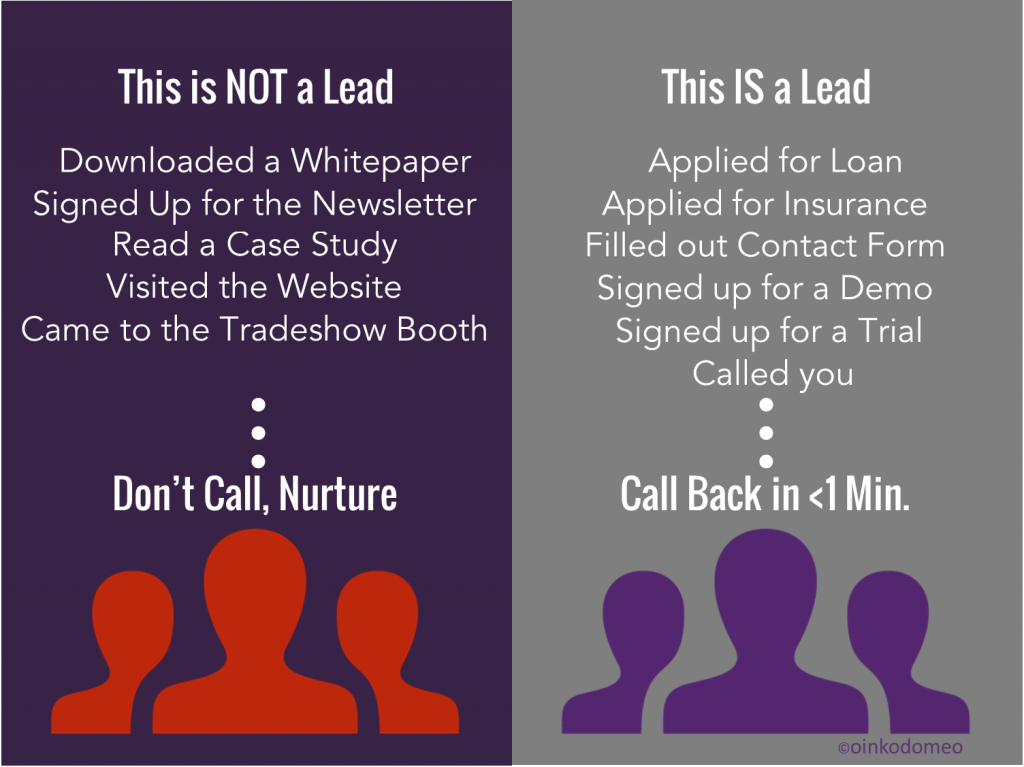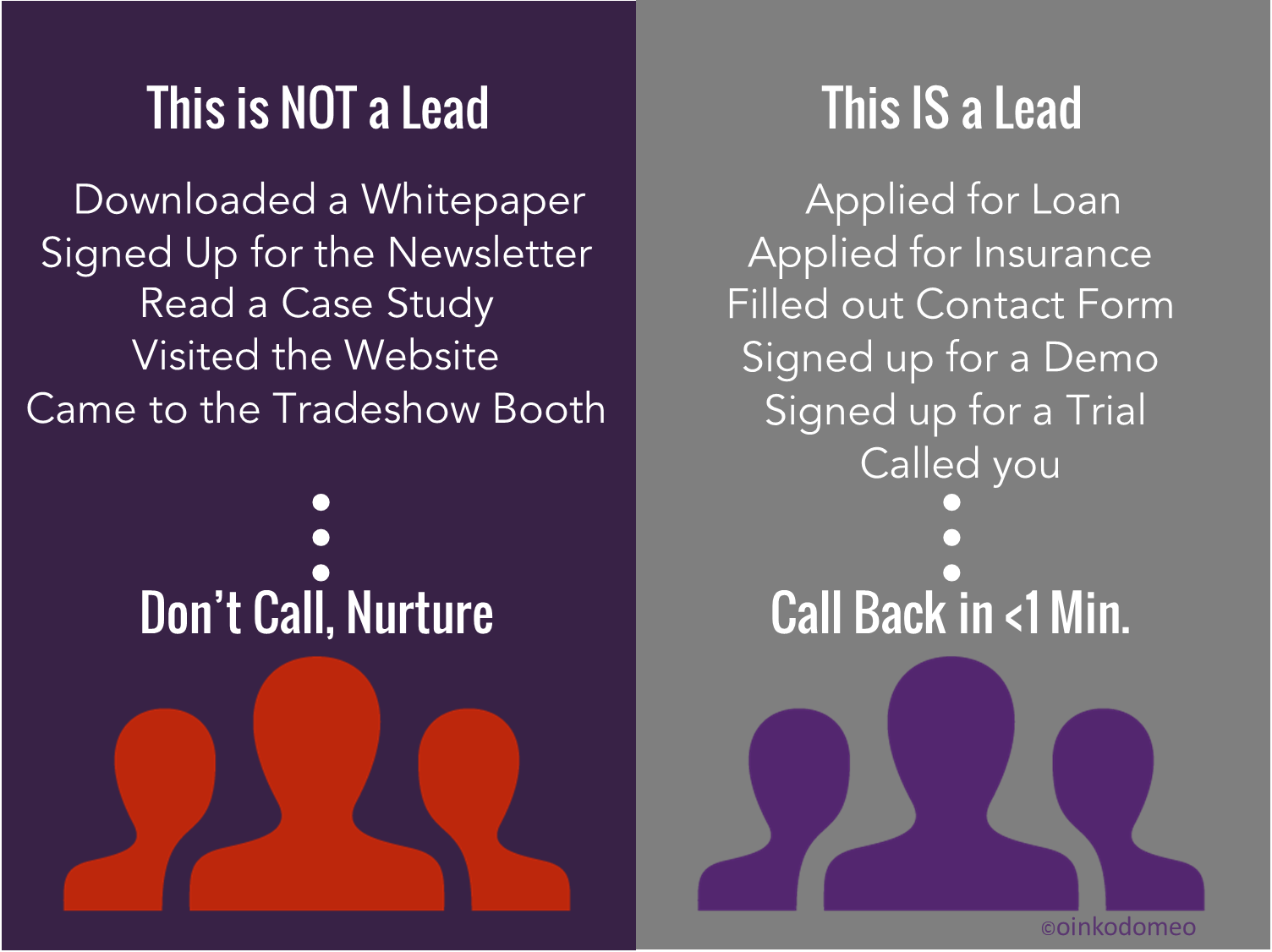What is the ideal lead response time?
 What is the lead response time goal for your company for web-generated leads? 1 day? 1 hour? 21 seconds?
What is the lead response time goal for your company for web-generated leads? 1 day? 1 hour? 21 seconds?
First, let’s start with the definition of LEAD. If it’s transactional, then jump on that phone right this second.
Someone calling to get mortgage or insurance rates. Or a loan. CALL NOW.
Someone completed a demo request form. CALL NOW.
Filled out the Contact Us form. WHAT ARE YOU WAITING FOR!?
Started a FREE trial. OK, CALL.
But if it’s not really a true lead, then you need to keep nurturing. Some of these situations might include:
Registered for a newsletter. Not waiting by the phone for you to call.
Downloaded a whitepaper. It depends. What else have they done or looked at? But still, not likely to be waiting by the phone for you to call in the next 21 seconds. They might even want to read the paper first.
Registered for a webinar. This one I’d make a priority right after the webinar ends. And call whether they managed to attend or not. If someone is willing to devote an hour to your product, or even intended to devote an hour, they are in the buying mode.
Cards from the Tradeshow fishbowl? No. If there was a hot lead, pull that one and prioritize for immediate follow up. Everything else goes to nurturing for further qualification because they are still just suspects.
You may have started to discern a pattern here. Before you can set a lead response goal, your trigger qualification requires a very precise definition of what a lead is and an agreement between sales and marketing to be effective. You don’t want sales intercepting leads that really still need nurturing. And on the other hand, you don’t want sales to be penalized if marketing hasn’t set up a workflow to get sales the urgent leads literally the second they arrive. No more handing out hot leads to sales a day (or week) too late! Those critical transaction forms are the ones you want to set up the auto-dial triggers that ring right to a sales desk.
Bottom line, if you have web call-back form technology, it’s important to be thoughtful about what forms you connect it to. On one you’ll get the “Wow you are responsive” comment and the other you’ll get the “Why are you bothering me?” comment.
Consider the History
When I started researching this topic, one of the case studies that showed up a lot (in the AA-ISP knowledgebase as well as online search) was a study from 2009. Wait! 2009!!!!???? That’s SEVEN years ago! In sales and marketing tool years that may as well be 1984.
When the case studies by InsideSales.com and MIT were done back in 2009 Marketing Automation tools were a lot less advanced and not as popular (Eloqua was just gaining momentum and Marketo was new). The lead hand-off process was manual in most companies. Marketing would pass along pretty much anything to Sales, either in business cards or a spreadsheet, or best case dumping them into the leads tab in Salesforce.com, and sales followed up on all of it. This was really inefficient, and getting to a lead within 1 day was an ideal goal. Then came what I call the stalking era. Sales folks discovering they could see when you opened an email or visited a page on the website – without having to wait for marketing. And they called you right then! Creepy!!! It wasn’t for another couple of years that lead scoring and automated nuturing became widely adopted.
More Contemporary Lead Response Time Guidance
Here are some of the resources I recommend when you are thinking about setting up your lead response process. It really starts with the product you have and where you are in the adoption curve. Your whole team set up should be around whether you have a brand new solution in a new area where people are calling you, hot for a demo. On the other end of the spectrum, a legacy enterprise system takes a different approach and a different team and follow up structure. Also look at the various steps in the lead capture and distribution flow, so the onus isn’t just on sales. Marketing needs to be effective in the capture and handoff. Check out what some of these experts are saying:
Trish Bertuzzi, The Sales Development Playbook
Andy Paul, Zero Time Selling
Geoffrey Moore, Two Different Sales Motions, on LinkedIn Pulse
In the end, lead response time is not so much about being a race as creating the right experience for the buyer. If the buyer is expecting you to call, then be prepared to do so immediately. Ideally, you want to be calling back within an hour. Think about the average window of attention most people have. After an hour they’ve moved on to the next call or meeting. If you can optimize that with technology, research shows that your results are better, the sooner you reach out. The days of waiting a day or more to reply to a Contact Me are over.

